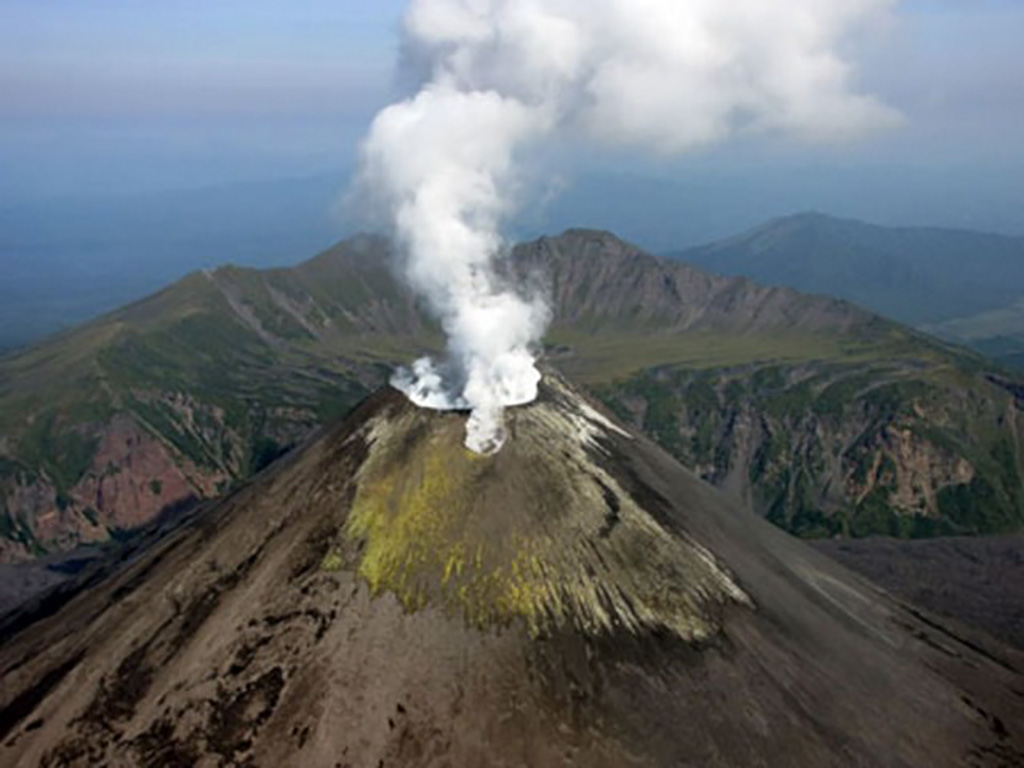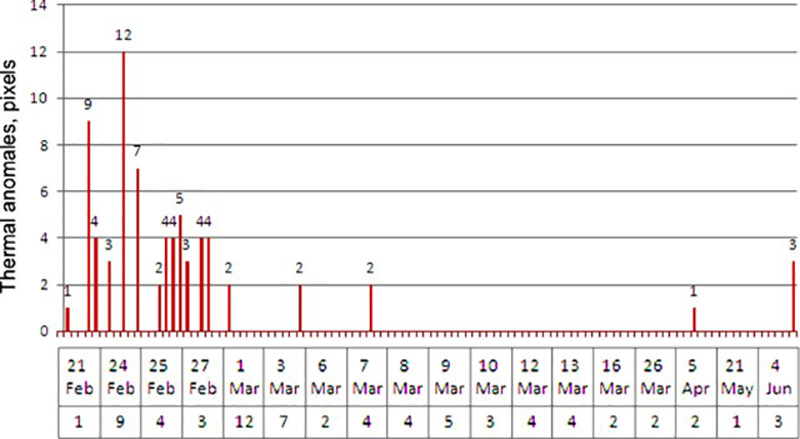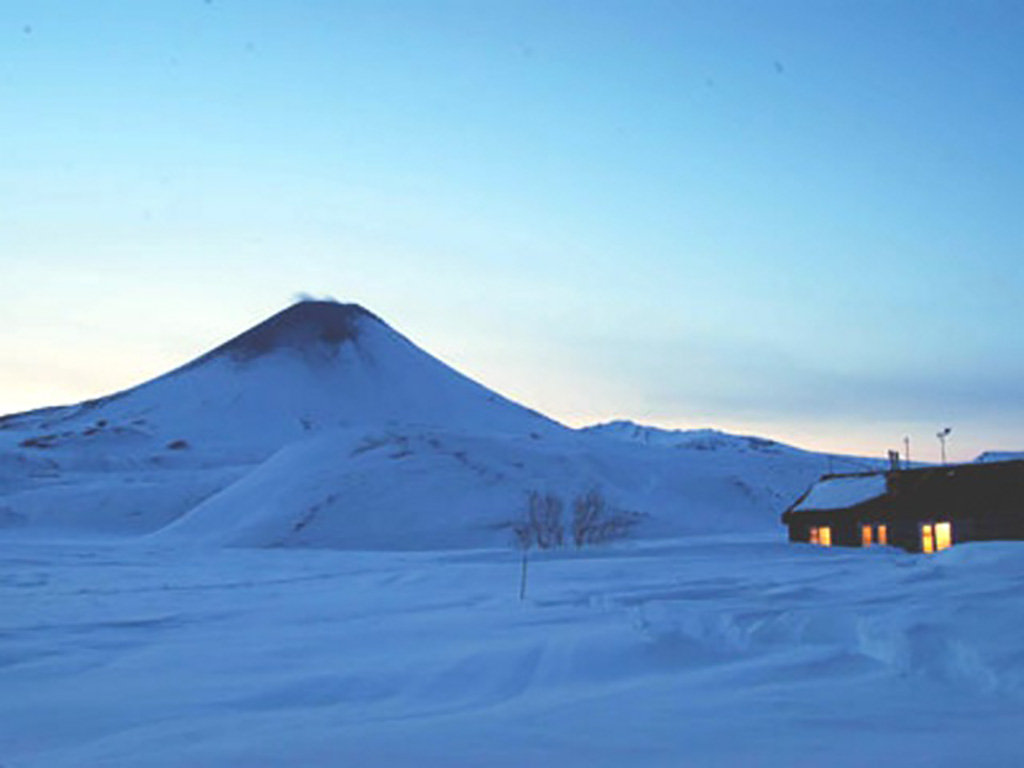Report on Karymsky (Russia) — August 2009
Bulletin of the Global Volcanism Network, vol. 34, no. 8 (August 2009)
Managing Editor: Richard Wunderman.
Karymsky (Russia) New 14 August explosion crater formed on S side of upper summit
Please cite this report as:
Global Volcanism Program, 2009. Report on Karymsky (Russia) (Wunderman, R., ed.). Bulletin of the Global Volcanism Network, 34:8. Smithsonian Institution. https://doi.org/10.5479/si.GVP.BGVN200908-300130
Karymsky
Russia
54.049°N, 159.443°E; summit elev. 1513 m
All times are local (unless otherwise noted)
This report covers 23 January to 9 September 2009, an interval with both thermal anomalies and ash plumes. A new explosion crater formed on the upper S flank on 14 August 2009. Many thermal anomalies were detected during 21 February to 1 March 2009 (figure 20).
During March 2009, Karymsky plumes were abundant (table 5). They were extending up to 200 km long on the 12th and 16th-17th. During 25 April and 19 May activity decreased although gas-and-steam emissions continued (figure 21).
Table 5. Summary of plumes observed at Karymsky during 21 February to 4 June 2009. Data compiled from listed sources.
| Date(s) | Ash Plume | Source |
| 21 Feb 2009 | 150 km NE | KEMSD; Tokyo VAAC |
| 04 Mar 2009 | 120 km SE | KEMSD; Tokyo VAAC |
| 05 Mar 2009 | 75 km ENE; 64 km SE | NOAA 16; NOAA 17 |
| 06 Mar 2009 | 160 km E; 115 km E | NOAA 17; NOAA 16 |
| 07 Mar 2009 | 115 km SE | NOAA 16 |
| 08 Mar 2009 | 50 km SW | NOAA 16; NOAA 17 |
| 09 Mar 2009 | 50 km SW; 30 km E | NOAA 17 |
| 12 Mar 2009 | 200 km E | KEMSD; Tokyo VAAC |
| 13 Mar 2009 | 130 km E | NOAA 17; NOAA 16 |
| 16-17 Mar 2009 | 200 km E | KEMSD; Tokyo VAAC |
| 26 Mar 2009 | ash deposits to 30 km S | KEMSD; Tokyo VAAC |
| 04 Jun 2009 | 30 km SE | KEMSD; Tokyo VAAC |
Volcanologists reported from a camp on Karymsky lake that at 1600 on 14 August 2009 they noticed a series of small ash emissions. They saw plumes rising to ~ 2.5 km altitude. As a result of the eruption, a crater formed on the volcano's upper S slope. The new explosion crater was round and deep, with a diameter of 70 m. At the time of the call the crater was still steaming to a height of 200 m above the crater (figure 22).
 |
Figure 22. Explosion crater on the S slope of Karymsky as seen on 18 August 2009 (four days after it formed). Photo by S. Chirkov. |
Geological Summary. Karymsky, the most active volcano of Kamchatka's eastern volcanic zone, is a symmetrical stratovolcano constructed within a 5-km-wide caldera that formed during the early Holocene. The caldera cuts the south side of the Pleistocene Dvor volcano and is located outside the north margin of the large mid-Pleistocene Polovinka caldera, which contains the smaller Akademia Nauk and Odnoboky calderas. Most seismicity preceding Karymsky eruptions originated beneath Akademia Nauk caldera, located immediately south. The caldera enclosing Karymsky formed about 7600-7700 radiocarbon years ago; construction of the stratovolcano began about 2000 years later. The latest eruptive period began about 500 years ago, following a 2300-year quiescence. Much of the cone is mantled by lava flows less than 200 years old. Historical eruptions have been vulcanian or vulcanian-strombolian with moderate explosive activity and occasional lava flows from the summit crater.
Information Contacts: Kamchatka Volcanic Eruptions Response Team (KVERT), Far East Division, Russian Academy of Sciences, 9 Piip Blvd., Petropavlovsk-Kamchatsky, 683006, Russia (URL: http://www.kscnet.ru/ivs/); Kamchatka Branch of the Geophysical Service, Russian Academy of Sciences (KB GS RAS), Piip Ave. 9, Petropavlovsk-Kamchatsky, 683006, Russia (URL: http://www.emsd.ru/~ssl/monitoring/main.htm); Sergei Chirkov and Alexander Manevich, IV&S FED RAS; Tokyo Volcanic Ash Advisory Center (VAAC), Tokyo, Japan (URL: http://ds.data.jma.go.jp/svd/vaac/data/).



